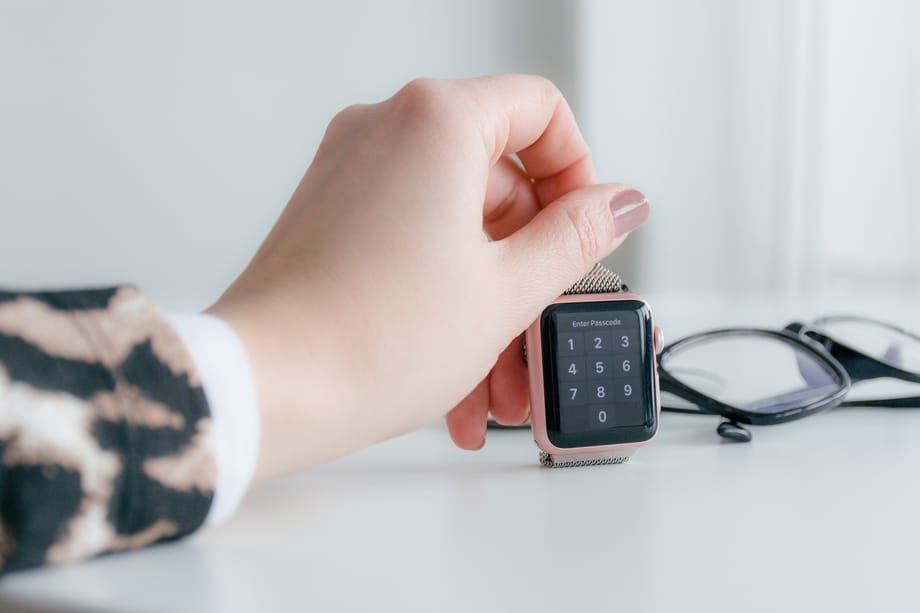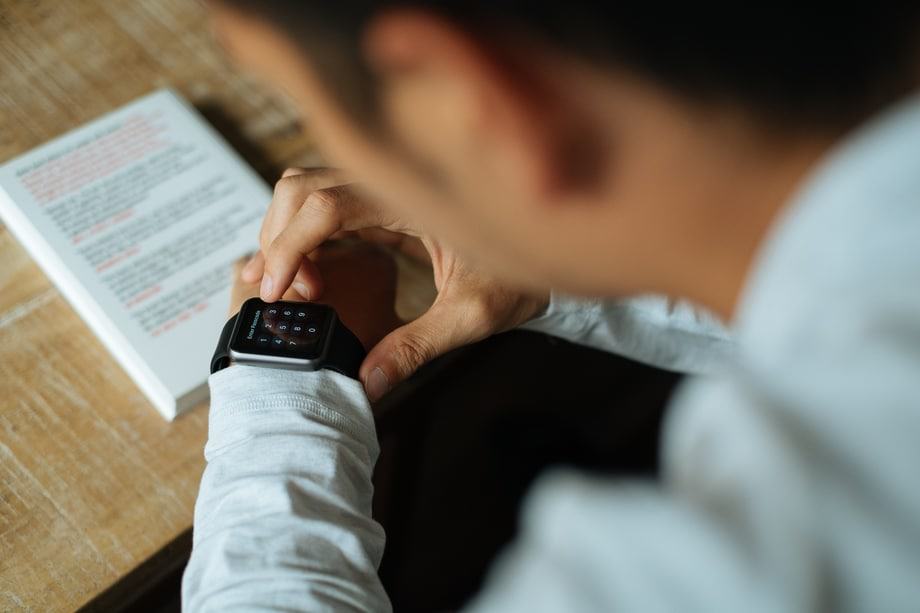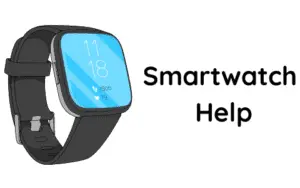There are a lot of concerns when it comes to the safety of your health and the data that is saved on your smartwatch.
Questions that come to mind are: Do they pose a possible cancer threat to people that constantly wear them and is the data that is saved on the watch during different tasks really only accessible to the user of the watch?
Let’s look at a few documented pieces of research and see if we can come up with a conclusive answer.
According to recent studies done by a group of European researchers, which were led by oncologist Dr. Lennart Hardell, smartwatches can potentially be bad for you, in fact, anything that emits electromagnetic radiation can be dangerous to a person but it’s important to note that the levels of exposure and radiation strength determine the dangerousness.
Although they do contain radioactive waves, the doses are in substantially low quantities, low enough to be barely noticeable.
If you take WiFi or Bluetooth for instance, the latter has a very low range, which indicates it has the lowest power and electromagnetic output, while the former contains the highest bandwidth, sometimes up to 5GHz.
A brief answer to the question would be that it is unknown for now whether smartwatches are safe to use when it comes to your health. The research that has been done so far can only tell you that there could be health risks. Smartwatches have only been around for a decade, which for now isn’t long enough. When it comes to the safety of your data and connected smart-home tech though, there will always be risks, for example, a thief could steal your device and use your device to open your smart front door.
Products | Features | |
* Great For Women * |
| |
* Great For Women * |
| |
* Great For Women * |
| |
* Great For Men * |
| |
* Great For Men * |
| |
* Great For Men * |
|

Quick Navigation
What Are The Specific Concerns When It Comes To WiFi, 4G, And Bluetooth?
Is Your Data Safe On Your Smartwatch?
Are Smartwatches For Kids Safe To Use?
What is a smartwatch?
Well, in the simplest of terms you can think of it as a mini computer that you can wear on your wrist.
This portable wrist-worn device is a rather recent device, and unlike its counterpart, the digital watch, the smartwatch contains smartphone-like features that can do anything from recording your heart rate to being a vital resource during scuba diving.
Smartwatches are typically managed with the help of a touchscreen, and they can be used to give you vital information and they can alert authorities if an accident has happened.
For example, the new Apple Watch has a sensor called the “fall sensor”.
Once the watch detects that the person who’s wearing the watch has fallen and doesn’t react after a predefined amount of time, the watch will immediately call the emergency services.
What are the specific concerns when it comes to WiFi, 4G, and Bluetooth?
As mentioned earlier, many of the concerns are based on hypothesis.
Some argue that since the World Health Organization and the International Agency for Research on cancer have both labeled cell phones as possible ‘carcinogens’, that the same would apply for smartwatches and other wearables.
For the most part, they operate on the same spectrum, but the important thing to keep in mind is that the term ‘possible’ here means that there is still no concrete proof.
Bluetooth here is perhaps the most harmless, simply because of its relatively low range, and hence any of the risks attached to it are mostly unfounded.
The potential risks on 4G however, becomes more and more substantial depending on your proximity to the base station.
If you live close to the base station then you don’t have to worry about increased radiation levels.
If however, you live far from the base station, then your device will need maximum power to get a signal, this increased power is mainly what causes radiation to be a potential problem, also the proximity to your device, and how long you are exposed to the radiation are important factors.
WiFi might give possible problems too.
It features the highest bandwidth, and with several routers in your home, there can be a possible risk.
According to John Moulder, the professor of Oncology at Medical College of Wisconsin, WiFi routers are potential risks, so ensuring you keep your distance reduces the amount of radiation your body is exposed to.
The electromagnetic waves that these devices emit are still not considered high enough to cause any significant damage, but perhaps it is better to be safe than sorry.
In a nutshell, the kind of electromagnetic waves contained here do not ionize the medium they pass through, and hence they do not cause the kind of damage that active electromagnetic waves do.
The cumulative, long term effects serve up a different risk factor especially in this age of the Internet of Things (IoT).
This is why Dr. Joel Moskowitz, the director for Family and Community Health at the University of Carolina emphasizes the need to reduce how much we use all these devices, and for how long.
He also advises people to switch off these devices when they are not in use, and to keep them away from pregnant women, as well as to minimize exposure to the nether regions as they may cause reproductive harm.
Finally, there are some concerns as to whether smartwatches are safe to use while driving.
There is very little legitimacy to this concern as it is pretty obvious that you are not supposed to use any device that isn’t hands-free while you’re driving.
The key here is to concentrate on driving and to limit anything that may act as a distraction.
Smartwatches don’t cause any inherent risk that isn’t caused by any other device that impedes your ability to drive safely.
So this premise is misplaced.
Is your data safe on your smartwatch?
According to intense research by Hewlett Packard on smartwatches and other various wearables, your data may not be as safe as you think.
The culmination of an analysis of over 70 smartwatches from major manufacturers found that there were major data related concerns.
These concerns range anything from information transfers to personal information that is stored on any of your devices.
First, many of the operating systems seemed incapable of performing crucial software updates that had encryption.
What this meant, essentially, is that the data could be easily intercepted, which left your devices vulnerable and susceptible to the firmware.
This is commonly referred to as a man-in-the-middle attack, which is usually a lot like eavesdropping.
What happens, essentially, is when you are transferring data between your smartphone and your smartwatch, the lack of encryption of this data makes it easy for a hacker to “spy” and get access to your private information.
If that’s not scary enough, then think about a scenario where although sniffing tools cannot intercept some varieties of information, they can hack into your system and get data that is in plain text.
This is according to research by Khandelwal, 2014.
In essence, a third party can easily transmit your Personal Identifiable Information simply by making use of the spaces created by the transfer of unencrypted data through different devices.
On a different scale, moving away from data transfer issues, there is also the huge problem of data that is stored on your smartwatch.
It has now been established that most wearables do not have any backup security protocol.
What does this mean?
Essentially, if your device offers an unlimited number of login attempts without blocking the user out, or if it does not have a specific number of times that someone can put in a wrong password before the secondary measurement kicks in, then you could have a problem.
Without these extra measurements, you are vulnerable to what is referred to as a brute force attack (BFA).
This is normally where someone tries to force their way into your device by guessing your password or pin.
At this point, if you don’t have any secondary security measurements in place, which is the case with many smart watches, then the hacker can keep trying until they get the password right, and once they get in, all your data that’s on your smartwatch will be exposed.
The lack of double level user identification is a huge drawback for many smart watches, especially in this day and age of the Internet of Things, where your wearables are connected to just about all your smart devices.
Most people don’t know just how vulnerable they are to hacking while being connected to business networks, the fact that most people actually sync all their devices, even their front doors and other personal information that is open and vulnerable to any manner of cybercrime.
While many people are focused on health repercussions that are purely hypothetical at this point, it is important to note that your data, your personal and business information is possibly not safe on your smartwatch.
This is why it is advisable, if possible, to limit data transfer to information that can be encrypted.
If this is not practical, then perhaps try and include an extra layer of protection via more complex passwords and pins.

Are smartwatches for kids safe to use?
Recent reports by various bodies including the Norwegian Consumer Council have labeled smartwatches specifically designed for kids as a possible recipe for disaster.
This is mainly due to the fact that the measurements that are put in to safeguard your child’s safety are the same ones that could be exposing them to danger.
After analyzing some brands of these GPS tracker wearables for kids, it was established that these smartwatches were vulnerable to hacking, giving any potential attacker sensitive information of the child’s exact location.
Getting access to the GPS information of the child can also give the attacker the child’s movements, information on where the child lives, what places they have been to in the course of the day and where they are at this very moment.
If that doesn’t stoke your concern, then think about the fact that an attacker who manages to hack into this smartwatch can actually contact your child without you knowing this.
Upon further analysis, it was also established that of the 4 brands that were tested, one was found to contain a built-in listening device.
Which means that with a cleverly planned man in the middle attack, such a device can have serious implications on safety, as the attacker can literally listen in on all your conversations.
What many parents fail to consider before buying these devices as well as other things in the realm of the IOT, is the fact that kids are naturally naïve, and they tend to be rather trusting.
This leaves them vulnerable on a massive scale, as it is highly possible for them to unwittingly give out tons of personal information.
The fact that you are incapable of deleting your account entirely or even the fact that the crucial feature of “geo-fencing” in many of these devices is dysfunctional are just a few of the main problems that parents have to contend with today.
It is therefore important for parents to be very selective on the kind of toys and wearables they give their kids, both in terms of health risks and overall safety on every regard.
Finally, the key question on any parents mind should be whether these smartwatches for kids actually help to keep kids safe, or if they are an avenue to a bigger danger.
They do give some level of security by allowing you to keep tabs on your kids, but is the impending risk worth the overall reward?
In my opinion, it is up to the parents to decide what’s best for their children. After all, every device is going to have downsides and upsides.

Conclusion
The problem with technology is the fact that it is ever evolving and ever necessary.
So, no matter how much risk it poses, there will only be one way of countering any of these negative effects and that is by mitigation.
The idea is to find ways to reduce, or ultimately get rid of the risk factors, and find ways to use technology without having to worry about the safety of your data or any health risks.
Other than that, smartwatches, as per current standards, are pretty safe to wear, and they have become a necessity to some people in today’s world.
Getting rid of them is about as practical as getting rid of all the cellphones, which is virtually impossible.
Products | Features | |
* Great For Women * |
| |
* Great For Women * |
| |
* Great For Women * |
| |
* Great For Men * |
| |
* Great For Men * |
| |
* Great For Men * |
|

